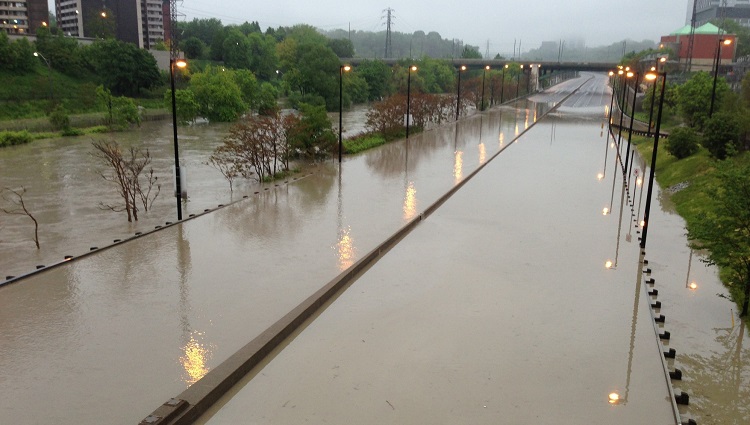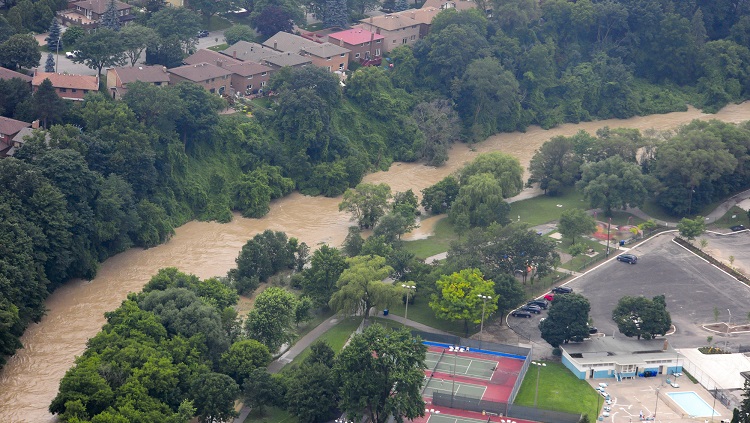You can become better prepared for flooding by knowing your risks, having a plan, and putting together an emergency kit. Learn more here about the current status in our watersheds, our real-time gauging network, and our recommended flood precautions.
TRCA REAL-TIME GAUGING
Explore the current conditions in our watershed. Toronto and Region Conservation Authority’s (TRCA) flood monitoring gauge network spans the GTA, continually monitoring in-stream water levels at TRCA dams and river stations. Real time stream flow, water level, and precipitation information is available HERE.
While the TRCA gauging website is designed as a portal for Flood Duty Officers and our municipal partners, limited access to data is available to the general public.
TRCA Gauging: How-to Videos
TRCA has created a series of videos designed as a user manual for the flood monitoring website. Each video includes step-by-step instructions on different features of the monitoring website. Click the links below to learn more.
- TRCA Gauging Website How-To 1: Introduction and Registration
- TRCA Gauging Website How-To 2: Homepage and Station Map
- TRCA Gauging Website How-To 3: Gauge Page Overview
- TRCA Gauging Website How-To 4: Creating Dashboards
- TRCA Gauging Website How-To 5: Downloads and Reports
- VIEW FULL PLAYLIST
GET PREPARED
Before a Flood:
Be flood ready by knowing your risks. Speak to your insurance provider to find out what is and isn’t covered by your policy. Check out the Government of Canada’s Flood Ready steps: Flood Ready First Steps. You should also create a household emergency plan ahead of time. This plan should detail the actions you and your family need to take before, during and after a flood emergency is declared.
Have a 72-hour emergency kit prepared for each member of your family. The kits should be easily accessible and easy to carry with you in case you have to evacuate your home. Use TRCA’s handy guide to create your 72-hour preparedness kit.
There are also some steps you can take before a flood to reduce the likelihood of damage to your home. Protect your property with flood ready fixes provided by the Government of Canada. Also check with your local Municipality for by-laws and incentive programs for protecting your property against the risks of flooding.
- Put weather protection sealant around basement windows and the base of ground-level doors.
- Install the drainage for downspouts a sufficient distance from your residence to ensure that water moves away from the building.
- Clear fire hydrants around your house.
- Consider installing a sump pump and zero reverse flow valves in basement floor drains. If you already have these devices, follow the manufacturer’s instructions for cleaning to ensure that they are functioning properly.
- Clean your eavestroughs. When they are blocked, rain can pour over the edges and could spill into your basement.
- Do not store your important documents or valuables in the basement. Keep them at a higher level, protected from flood damage.
If a Flood is Forecast Near You or is Imminent:
- Turn off basement furnaces and the outside gas valve.
- Take special precautions to safeguard electrical, natural gas or propane heating equipment.
- If there is enough time, consult your electricity or fuel supplier for instructions on how to proceed.
- In a rural farm setting, sheltering livestock may be the wrong thing to do. Leaving animals unsheltered is preferable because flood waters that inundate a barn could trap animals inside, causing them to drown.
- Stay away from fast flowing streams, rivers, and areas known to flood.
- Move furniture, electrical appliances and other belongings to floors above ground level.
- Remove toxic substances such as pesticides and insecticides from the flood area to prevent pollution.
- Remove toilet bowls and plug basement sewer drains and toilet connections with a wooden stopper.
- Disconnect eavestroughs if they are connected to the house sewer.
- In some cases, homes may be protected with sandbags or polyethylene barriers. This approach requires specific instructions from your local emergency officials.
- Do NOT attempt to shut off electricity if any water is present. Water and live electrical wires can be lethal. Leave your home immediately and do not return until authorities indicate it is safe to do so.
During a Flood
- BE CAUTIOUS AROUND FLOODED AREAS.
- Stay away from rivers and streams; frozen banks and/or soft banks along the rivers can be slippery.
- It is not recommended to walk or drive on a flooded area or road. If you are on foot, fast water could sweep you away. If you are in a car, do not drive through flood waters or underpasses. The water may be deeper than it looks and your car could get stuck or swept away by fast water. An average car cannot pass through water deeper than 0.3m (1ft).
- If you are caught in fast-rising waters and your car stalls, leave it and save yourself and your passengers by moving to higher ground.
- Do not swim outdoors during a rainfall event.
- Avoid crossing bridges if the water is high and flowing quickly.
- Do not attempt to rescue friends or pets from the river if they fall in, as you may also be overcome by the force of the river. Call 911 for help immediately.
- Tune in to your radio for updates on affected areas, safe access roads, where to go and what to do if the local emergency team asks you to leave your home.
- Keep your emergency kit close at hand, in a portable container such as a duffel bag, back pack, or suitcase with wheels.
- Be prepared for disruptions to essential services and transportation.

If You Need to Evacuate
- Evacuate your home when you are advised to do so by local emergency authorities. Ignoring such a warning could jeopardize the safety of your family or those who might eventually have to come to your rescue.
- Take your emergency kit with you.
- Follow the routes specified by officials. Don’t take shortcuts. They could lead you to a blocked or dangerous area.
- Make arrangements for pets.
- Time permitting, leave a note informing others when you left and where you went. If you have a mailbox, leave the note there.
After a Flood
Restore your home to good order as soon as possible to protect your health and prevent further damage to the house and its contents.
Re-entering Your Home:
- Do not return home until authorities have advised that it is safe to do so.
- If the main power switch was not turned off prior to flooding, do not re-enter your home until a qualified electrician has determined it is safe to do so.
- Appliances that may have been flooded pose a risk of shock or fire when turned on. Do not use any appliances, heating, pressure, or sewage system until electrical components have been thoroughly cleaned, dried, and inspected by a qualified electrician.
- The main electrical panel must be cleaned, dried, and tested by a qualified electrician to ensure that it is safe.
- Depending on where you live, your municipal or the provincial inspection authority is responsible for the permitting process required before your electric utility can reconnect power to your home.
Water:
- Flood water can be heavily contaminated with sewage and other pollutants. It can cause sickness and infections.
- If through colour, odour or taste you suspect that your drinking water has been contaminated, don’t drink it.
- Household items that have been flood-damaged will have to be discarded according to local regulations.
Documentation:
- Record details of flood damage by photograph or video, if possible.
- Register the amount of damage to your home with both your insurance agent and local municipality immediately.
Cleanup:
- Maintain good hygiene during flood cleanup. Minimize contact with floodwater or anything that may have been in contact with it. Keep children away from contaminated areas during cleanup operations.
- Recommended flood cleanup equipment:
- Gloves
- Masks and other protective gear
- Pails, mops and squeegees
- Plastic garbage bags
- Unscented detergent
- Large containers for soaking bedding, clothing and linens, and clotheslines to hang them to dry
- Depending on your situation, you may need to rent additional equipment such as extension cords, submersible pumps, wet/dry shop vacuums, a carbon monoxide sensor and dehumidifiers, fans or heaters.
- When using the equipment, keep extension cords out of the water.
You can learn more at getprepared.gc.ca.

Who to Contact
- If you are in danger, call 911 immediately.
- TRCA 24-hour floodline : 416-661-6514
- TRCA rental property concerns: 416-295-0127
- To report localized flooding on municipal roads, blocked catch basins or municipal infrastructure, contact your local Municipality
The responsibility for flood contingency planning is shared by municipalities, conservation authorities and the Ontario Ministry of Natural Resources and Forestry (MNRF). As with all emergencies, municipalities have the primary responsibility for the welfare of residents during flood events and may call upon the Province for support if required.
MNRF and conservation authorities are primarily responsible for operating a Flood Forecasting and Warning system which involves issuing messages and providing advice to municipalities.
Municipalities:
- City of Toronto (Dial 311 for city services)
- Durham Region
- Town of Ajax
- City of Pickering
- Town of Uxbridge
- York Region
- Township of King
- City of Vaughan
- Town of Richmond Hill
Other Conservation Authorities:
Other Important Contacts:
